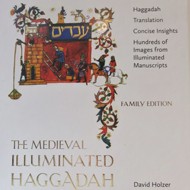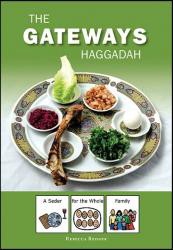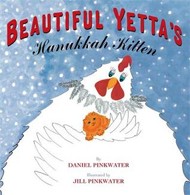Sometimes the story of a book is almost as compelling as the book itself, and so it is with The Monk’s Haggadah. While doing research on haggadot at the National Library of Israel in 1999 – 2000, David Stern, professor of classical Hebrew literature at the University of Pennsylvania, noticed several pages of Latin prefacing an illustrated haggadah. Intrigued, he asked for a printout. Some months later he showed it to his friend Christoph Markschies, now chair of ancient Christianity at Humboldt University in Berlin, whose curiosity was also piqued and who arranged to have it translated. The translation revealed, for the first time in a primary source, a report of the use of the blood of a Christian child in the Passover ritual as well as a wealth of material on Jewish practice in fifteenth-century Germany.
Stern and Markschies had begun planning the publication of the haggadah when it was suggested they add a chapter on the art, and they were soon joined in the editing of the book by Sarit Shalev-Eyni, chair of art history at Hebrew University. Shalev-Eyni noted that the codex was not just another charming medieval haggadah; she cited four illustrations that have iconography suggesting Christian significance. The fact that the haggadah was a gift from a preacher to the monastery at Tegernsee, noted for its outstanding library, only added to the mystery of the haggadah and the possibility that it was intended for Christian study.
In three highly informative essays Stern, Markschies, and Shalev-Eyni explore the making and history of the haggadah. Shalev-Eyni explains in detail the steps in creating an illustrated haggadah — the work of the scribe, vocalizers, illuminators, and others — and some of the irregularities in this one that underline the question of its purpose. Markschies discusses the path of the haggadah to Tegernsee and the circle of monks who studied Judaism in the Middle Ages as a source for early Christianity, as well as Erhard van Pappenheim, a knowledgeable Dominican Hebraist who translated and explained the haggadah at the request of the abbot of Tegernsee. In his prologue, which was bound into the codex, Erhard relates the seder to the Eucharist. Erhard was present at a blood libel trial in Trent in 1475, and he derived much of his knowledge of Jewish practice from the confessions of the Jewish defendants, but he was also familiar with a range of Jewish books. The value of his prologue, Stern shows, is in Erhard’s material on medieval Jewish practice. Although the confessions about the use of blood in matzos and kiddush wine are almost certainly the result of torture — not acknowledged by Erhard — other practices are accurately recorded in what Stern sees the first “ethnography” of medieval Jewish practice.
Erhard’s prologue, in both its original Latin and in translation, follows the essays. The passages on the reputed blood rituals are difficult to read even today, knowing their influence. On the other hand, Erhard is a serious scholar whose interest in the seder is based on its similarities to the Eucharist, which he carefully points out, and his report of preparations for the seder has fascinating details. The book ends with a complete facsimile of the codex.
A stunning work of scholarship and bookmaking, The Monk’s Haggadah raises more questions than it answers, but it also tells an absorbing story of medieval scholarship. As a prelude to Passover it is perhaps unsettling to read this interpretation of the most beloved of Jewish rituals and its picture of fifteenth-century Jewish life in Germany. But as the fascinating and unsolved story of this unique haggadah and as a tribute to scholarly collaboration, The Monk’s Haggadah is an outstanding accomplishment. Illustrations, index, map, notes.
Related Content:
- Passover Picks reading list
- Rachel Cantor: Passover in Pakistan
- Moshe Kasher: The Lost Afikomen
Maron L. Waxman, retired editorial director, special projects, at the American Museum of Natural History, was also an editorial director at HarperCollins and Book-of-the-Month Club.




